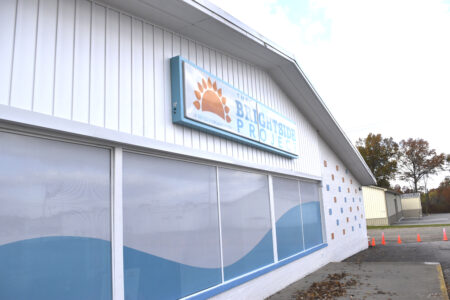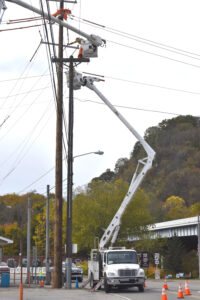Allison co-chairs NIH grant session
EAST PALESTINE — The six universities awarded National Institute of Health (NIH) grants then-president Joe Biden announced during his visit to East Palestine in February of 2024 to study the impacts of the 2023 train derailment on human and environmental health were the topic of a conference in Atlanta last week.
At the annual meeting of the International Society of Exposure Science (ISES) and the International Society of Environmental Epidemiology (ISEE), researchers, public health leaders, and community advocates gathered for a session titled “Joining Forces in the Face of Disaster: How Five Universities Address Exposure and Health Concerns Resulting from the East Palestine, Ohio Train Derailment.”
Misti Allison, a resident of East Palestine and a member of Columbiana County General Health District Board, co-chaired the session along with Dr. Erin Haynes, Kurt W. Deuschle Professor of Preventive Medicine and Environmental Health at the University of Kentucky.
For Allison, the work is not only professional — it’s deeply personal.
“The derailment will always be part of our story, but it doesn’t have to define our future,” Allison said. “By working hand in hand with researchers, our community is not only finding answers. We’re building resilience for whatever comes next. This collaboration among universities has helped bring clarity, and most importantly, hope.”
Aubrey Miller of the National Institute of Environmental Health Sciences (NIEHS), who provided background on the federal response to the derailment and the institute’s decision to fund rapid-response research projects, both opened the sessions and moderated the Q&A portion that helped connect the audience’s questions with the expertise of the research teams.
“When a disaster like this occurs, communities need answers quickly,” Miller said during the session. “Our role at NIEHS was to mobilize science as fast as possible, while making sure the research is grounded in transparency and community trust.”
Miller first spoke to residents in 2023 during an EPA informational session on public health held in East Palestine. Haynes also spoke at that public health meeting and has been tracking the potential health impacts of the rail disaster. As an environmental scientist at the University of Kentucky College of Public Health, Haynes is leading one of the studies. She also brought a team to East Palestine to collect biological samples from residents and provide residents with wristbands that measure air quality in the surrounding environments.
The University of Kentucky, Texas A&M University, Case Western Reserve University, the University of Pittsburgh, and University of California San Diego were five universities that were awarded the six grants – Pitt received two — and the universities have shared data, coordinated community meetings, and aligned their approaches.
“This type of cross-university collaboration doesn’t happen every day,” said Haynes. “But disasters demand that we work differently. Together, we’ve been able to listen more closely to residents, respond to their needs faster, and make sure our science has real-world impact. By aligning our methods and sharing data, we can deliver stronger science and greater impact for East Palestine, and for communities facing the next disaster.”
Each institution brought its own expertise to the table:
— Texas A&M University scientist Natalie Johnson and collaborator, Harvard University scientist Peng Gao, developed a system for environmental monitoring, analyzing air, soil, and water samples to estimate health risks.
— University of Kentucky researchers launched a health tracking study to follow East Palestine residents over time, documenting symptoms, stress, and emerging conditions.
— Case Western Reserve University’s Healthy Futures study, shared by Anthony Orsino and led by Fred Schumacher, investigated whether chemical exposure could be linked to changes in somatic mutation rates — markers tied to long-term health outcomes.
– University of Pittsburgh researchers, led by Dean Maureen Lichtveld and East Palestine community member Erika Kinkead, focused on community engagement, ensuring residents had a voice in shaping the research.
– University of California San Diego’s Janhavi Kulkarni explored parallels between the derailment’s chemical exposures and chronic illnesses observed in Gulf War veterans in their research project spearheaded by Dr. Beatrice Golomb.
Allison said that the speakers emphasized that East Palestine’s story holds lessons for the future. With climate change, industrial accidents, and chemical disasters expected to rise, the model of rapid, collaborative, community-centered research may serve as a blueprint for how science can respond in times of crisis.
“East Palestine is not just a case study,” she said. “It’s a reminder that behind every environmental disaster are families who need to know they’ll be okay. And when universities join forces with communities, we get closer to answers that matter.”
Allison has continued to advocate for public health and the residents that lived through the rail disaster. Since becoming one of the first faces of the derailment. She testified at the first senate hearings held in the wake of the derailment in March of 2023 and has penned multiple op-eds that have appeared on theHill.com and in Time Magazine.
In May, Allison testified at a spotlight forum in the Senate Environment and Public Works Committee. She was asked to testify about the EPA’s disaster relief in East Palestine and how the proposed cuts to the agency’s 2026 budget – reported to be 65% – would be detrimental.


